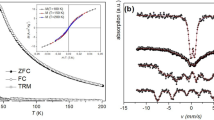Abstract:
When a spin glass is cooled down, a memory of the cooling process is imprinted in the spin structure. This memory can be disclosed in a continuous heating measurement of the ac-susceptibility. E.g., if a continuous cooling process is intermittently halted during a certain aging time at one or two intermediate temperatures, the trace of the previous stop(s) is recovered when the sample is continuously re-heated [#!uppsalaSaclay!#]. However, heating the sample above the aging temperature, but keeping it below , erases the memory of the thermal history at lower temperatures. We also show that a memory imprinted at a higher temperature can be erased by waiting a long enough time at a lower temperature. Predictions from two complementary spin glass descriptions, a hierarchical phase space model and a real space droplet picture are contested with these memory phenomena and interference effects.
Similar content being viewed by others
Author information
Authors and Affiliations
Additional information
Received 28 April 1999
Rights and permissions
About this article
Cite this article
Jonason, K., Nordblad, P., Vincent, E. et al. Memory interference effects in spin glasses. Eur. Phys. J. B 13, 99–105 (2000). https://doi.org/10.1007/s100510050014
Issue Date:
DOI: https://doi.org/10.1007/s100510050014




